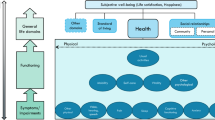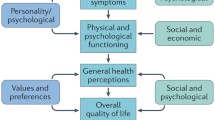Summary
There are now a large number of instruments available for assessing healthrelated quality of life, many of which are used within economic evaluations. When considering the use of quality—of—life instruments, meaningful questions need to be asked to determine whether an instrument has been used judiciously. Such questions should consider whether the instrument is valid and suitable for the particular study question, whether the instrument is compatible with the economic evaluation framework used, and subsequently whether the conclusions presented in the study are legitimate. In order to illustrate the value of these questions we have applied them to a number of economic evaluations. The studies used were identified via a systematic review of the health economics literature.
In our assessment of a sample of published material, we found that reporting is frequently unhelpful and that the inappropriate use of instruments and techniques casts doubt on the conclusions of economic evaluations. Furthermore, our systematic review of the health economics literature has shown that the general format of reported economic evaluations falls short of the commonly accepted ideal. We examined the health economics literature for 1995 and only identified a handful of studies which satisfied the economic evaluation criteria as accepted by most economists.
It is hoped that raising awareness of these issues will urge evaluators, referees and publishers not to lose sight of the needs of the decision—maker when considering the detail which should be present in a reported evaluation.
Similar content being viewed by others
References
Brazier JE, Deverill M, Harper R, et al. A review of the use of health status measures in economic evaluation. London: UK National Health Service Research and Development (NHSR&D). In press
Culyer AJ. Measuring health: lessons for Ontario. Toronto: University of Toronto Press, 1978
Torrance GW. Measurement of health state utilities for economic appraisal: a review. J Health Econ 1986; 5: 1–30
Williams A, Donaldson C, Atkinson J, et al. Should QALYs be programme specific? J Health Econ 1989; 8: 485–91
Feeny DH, Torrance GW. Incorporating utility based quality of life assessment measures in clinical trials. Med Care 1989 27 (3): S190–204
Nord E. Methods for quality adjustment of life years. Soc Sci Med 1992; 34: 559–69
Drummond M, Stoddart GL, Torrance GW. Methods for the economic evaluation of health care programmes: Oxford: Oxford University Press, 1987
Gournay K, Brooking J. The community psychiatric nurse in primary care: an economic analysis. J Adv Nurs 1995; 22: 769–78
Kennedy W, Reinharz D, Tessier G, et al. Cost utility of chemotherapy and best supportive care in non—small cell lung cancer. Pharmacoeconomics 1995; 8 (4): 316–23
Kerridge RK, Glasziou PP, Hillman KM. The use of ‘qualityadjusted life years’ (qalys) to evaluate treatment in intensive care. Anaesth Intensive Care 1995; 23: 322–31
Mark DB, Hlatky MA, Califf RM, et al. Cost effectiveness of thrombolytic therapy with tissue plasminogen activator as compared with streptokinase for acute myocardial infarction. N Engl J Med 1995; 332: 1418–24
Cottrell JJ, Openbrier D, Lave JR, et al. Home oxygen therapy: a comparison of 2–vs. 6−month patient reevaluation. Chest 1995; 107 (2): 358–61
Johnson BF, Evans L, Drury R et al. Surgery for limb threatening ischaemia: a reappraisal of the costs and benefits. Eur J Vasc Endovasc Surg 1995; 9 (2): 181–8
Knobbe CA, Carey SP, Rhodes L, et al. Benefit—cost analysis of community residential versus institutional services for adults with severe mental retardation and challenging behaviors. Am J Ment Retard 1995; 99 (5): 533–4
Lawrence K, Mc Whinnie D, Goodwin A, et al. Randomised controlled trial of laparoscopic versus open repair of inguinal hernia: early results. BMJ 1995; 311: 981–5
Prince JM, Manley MS, Whiteneck GG. Self—managed versus agency—provided personal assistance care for individuals with high level tetraplegia. Arch Phys Med Rehabil 1995; 76: 919–23
Uyl de Groot CA, Hagenbeek A, Verdonck LF, et al. Cost—effectiveness of abmt in comparison with chop chemotherapy in patients with intermediate— and high—grade malignant nonhodgkin’s lymphoma (nhl). Bone Marrow Transplant 1995; 16: 463–70
Wimo A, Mattson B, Krakau I, et al. Cost—utility analysis of group living in dementia care. Int J Technol Assess Health Care 1995; 11 (1): 49–65
Sheldon TA. Problems of using modelling in the economic evaluation of health care. Health Econ 1996; 5: 1–13
Patterson RE, Eisner RL, Horowitz SF. Comparison of cost—effectiveness and utility of exercise ECG, single photon emission computed tomography, positron emission tomography, and coronary angiography for diagnosis of coronary artery disease. Circulation 1995; 91: 54–65
Cohen DJ, Baim DS. Coronary stenting: costly or cost—effective? J Invasive Cardiol 1995; 7 Suppl. A: 36A–42A
Etchason J, Petz L, Keeler E, et al. The cost effectiveness of preoperative autologous blood donations. N Engl J Med 1995; 332: 19–24
Yin D, Baum RA, Carpenter JP, et al. Cost—effectiveness of MR angiography in cases of limb—threatening peripheral vascular disease. Radiology 1995; 197: 757–64
Glotzer DE, Freedberg KA, Bauchner H. Management of childhood lead poisoning: clinical impact and cost—effectiveness. Med Decis Making 1995; 15: 13–24
Author information
Authors and Affiliations
Corresponding author
Rights and permissions
About this article
Cite this article
Deverill, M., Brazier, J., Green, C. et al. The Use of QALY and Non—QALY Measures of Health—Related Quality of Life. Pharmacoeconomics 13, 411–420 (1998). https://doi.org/10.2165/00019053-199813040-00004
Published:
Issue Date:
DOI: https://doi.org/10.2165/00019053-199813040-00004




